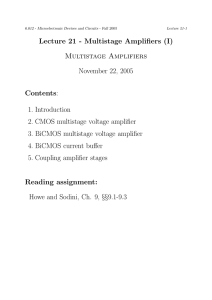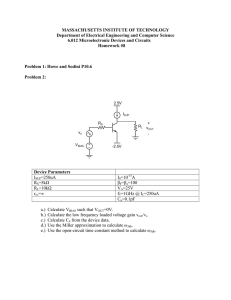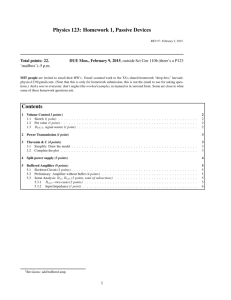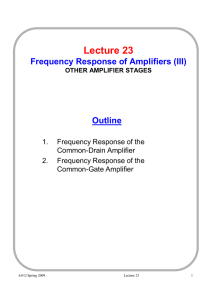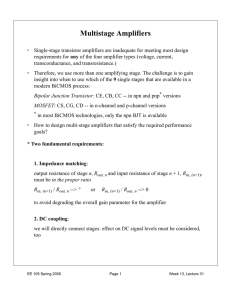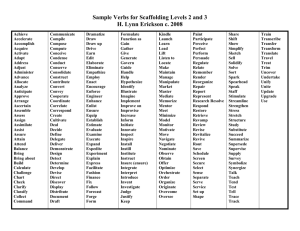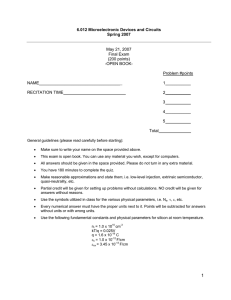Lecture 24 Multistage Amplifiers (I) Outline
advertisement
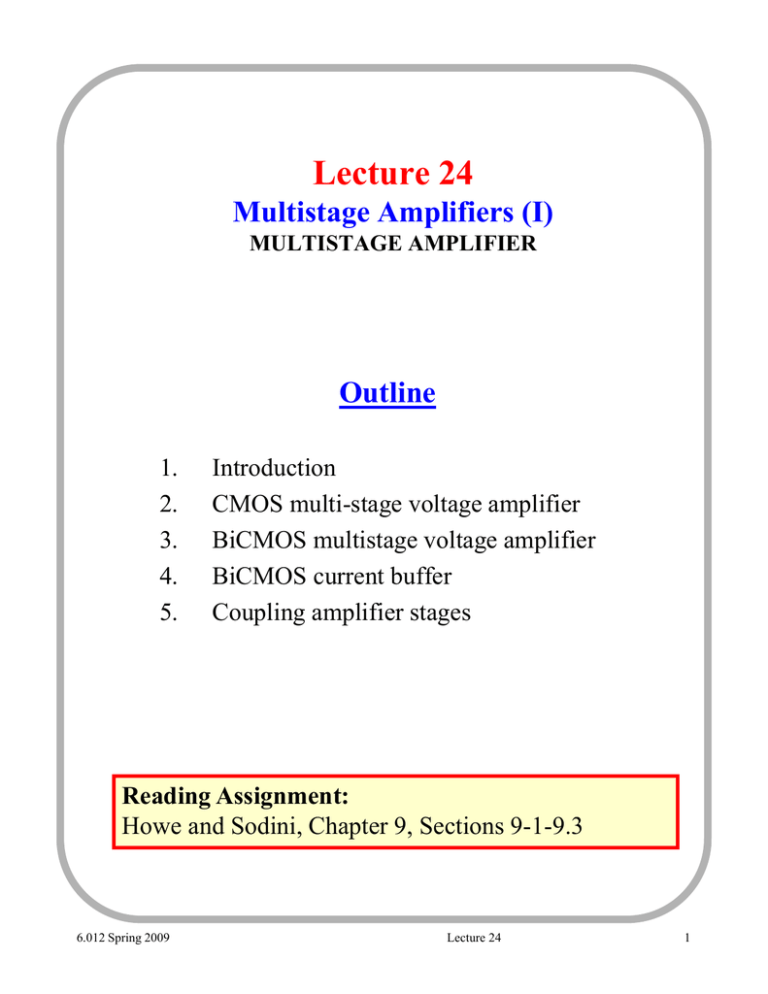
Lecture 24
Multistage Amplifiers (I)
MULTISTAGE AMPLIFIER
Outline
1.
2.
3.
4.
5.
Introduction
CMOS multi-stage voltage amplifier
BiCMOS multistage voltage amplifier
BiCMOS current buffer
Coupling amplifier stages
Reading Assignment:
Howe and Sodini, Chapter 9, Sections 9-1-9.3
6.012 Spring 2009
Lecture 24
1
1. Introduction
Most often, single stage amplifier does not accomplish
design goals:
• Need more gain than could be provided by a single
stage
• Need to adapt to specified RS and RL to maximize
efficiency
⇒ Multistage amplifier
VBIAS
Issues:
• What amplifying stages should be used and in what
order?
• What devices should be used, BJT or MOSFET?
• How is biasing to be done?
6.012 Spring 2009
Lecture 24
2
Summary of single stage amplifier characteristics
Stage
Avo, Aio
Rin
Common
Avo = −gm(ro //roc)
Source
∞
gm
Common Avo ≈
g m + gmb
Drain
∞
Common
Gate
Common
Avo=−gm(ro //roc)
Emitter
Avo ≈1
Common
Base
Aio ≈ −1
ro // roc
1
gm + gmb
Key
Function
Transconductance
amplifier
Voltage
Buffer
Current
roc //[ro (1+ gm RS )]
buffer
1
g m + g mb
Aio ≈ −1
Common
Collector
Rout
rπ
rπ + β o (ro // roc // R L )
ro // roc
Transconductance
amplifier
R
1
+ S
gm βo
Voltage
buffer
roc //[ro (1+ gm (rπ // RS ))]
1
gm
Current
buffer
Differences between BJT’s and MOSFETs
BJT
rπ =
MOSFET
βo
I
gm = C
Vth
V
ro = A
IC
6.012 Spring 2009
g mb ∝ g m
gm
>
>
gm = 2
ro =
W
μCox I D
L
1
λI D
Lecture 24
3
2. CMOS Multistage Voltage Amplifier
Goals:
•
•
•
High voltage gain, Avo
High input resistance, Rin
Low output resistance, Rout
Good starting point: Common-Source stage:
•
•
•
Rin=∞
Avo=-gm(ro//roc), probably insufficient
Rout= (ro//roc), too high
6.012 Spring 2009
Lecture 24
4
CMOS Multistage Voltage Amplifier (contd.)
Add second CS stage to get more gain:
•
•
Rin=∞
Avo=gm1(ro1//roc1) gm2(ro2//roc2)
•
Rout= (ro2//roc2), still too high
Add CD stage at output (to reduce Rout):
•
Rin=∞
gm3
• Avo = g m1(ro1 || roc1 )g m2 (ro2 || roc2 ) g
m3 + gmb3
1
•
Rout =
6.012 Spring 2009
g m3 + g mb3
Lecture 24
5
3. BiCMOS multistage voltage amplifier
Avo(CE) > Avo(CS) because gm(BJT) > gm(MOSFET), but..
CS stage is best first stage, since Rin=∞.
How about adding a CE stage following the CS stage?
(ro1 ⎢⎢roc1)
RS
+
vs +
−
vin1
+
−
−
CS
Av1vin1
(ro2 ⎢⎢roc2)
+
vin2
+
r 2
−
+
−
Av2vin2
vout
RL
−
CE
However, inter-stage loading degrades gain:
Rout1 = ro1 || roc1 >> Rin2 = rπ2
There is a voltage divider between stages
rπ2
Rin2
Rin2
≈
≈
<< 1
Rout1 + Rin2 Rout1 ro1 || roc1
Additional gain provided by the CE stage is mostly lost
to inter-stage loading.
6.012 Spring 2009
Lecture 24
6
BiCMOS multistage voltage amplifier (contd.)
Use two CS stages, but add CC stage at output:
+
vs +
−
ro2 ⎢⎢roc2
1
gm3 +
βo3
(ro2 ⎢⎢roc2)
RS
vin
+
−
Av1Av2vin
+
vin3
−
+
r
3 + βo3(ro3 ⎢⎢roc3 ⎢⎢RL)
+
−
vin3
vout
RL
−
−
CS − CS
CC
Inter-stage loading:
Rout 2 = ro2 || roc2 , Rin3 = rπ3 + βo 3 (ro3 || roc3 || RL )
Then, inter-stage loss:
rπ3 + βo3 (ro3 || roc3 || RL )
Rin3
=
Rout 2 + Rin3 ro2 || roc2 + rπ3 + βo3 (ro3 || roc3 || RL )
Better than trying to use a CE stage, but still pretty bad.
The good thing is that Rout has improved:
1
Rout2
1
r || r
Rout = Rout3 =
+
=
+ o2 oc2
gm3
gm3
βo3
βo3
Since, in general gm(BJT) > gm(MOSFET), Rout could be
better than CD output stage if ro2||roc2 is not too large.
Otherwise, CD output stage is better.
6.012 Spring 2009
Lecture 24
7
BiCMOS multistage voltage amplifier (contd.)
Better voltage buffer: cascade CC and CD output stages
What is the best order?
Since Rin(CD)=∞, best to place CD first:
+
+
vs +
−
+
−
vin
1
1
gm4 + β (g + g )
o4 m3
mb3
1
(gm3 + gmb3)
(ro2 ⎢⎢roc2)
RS
Av1Av2vin
−
vin3
−
+ v
in3
−
+
+
vin4
r 4 + βo4(RL ⎢⎢ro ⎢⎢roc)
−
CS − CS
+ v
in4 vout
−
RL
−
CD − CC
Inter-stage loading:
Rin3
=1
Rin3 + Rout2
Rin4
=
Rin4 + Rout3
rπ 4 + βo4 (ro4 || roc4 || RL )
≈1
1
+ rπ 4 + βo4 (ro4 || roc4 || RL )
gm3 + g mb3
The output resistance is excellent:
Rout = Rout4 =
6.012 Spring 2009
R
1
1
+ out3 =
+
gm4 βo4
gm4 βo4(gm3 + gmb3)
1
Lecture 24
8
4. BiCMOS current buffer
Goals:
• Unity current gain, Ai=1
• Very low input resistance, Rin
• Very high output resistance, Rout
Start with a common-base stage:
• Aio = −1
1
• Rin =
gm
{
}
• R out = roc || ro [1 + g m (rπ || RS )]
Note that if RS is “high enough”, Rout ≈ roc||(βoro).
Can we increase Rout further by adding a second CB
stage?
6.012 Spring 2009
Lecture 24
9
BiCMOS current buffer (contd).
CB-CB Current Buffer
iin1
is
RS
iout
iin2
1
gm1
−iin1
βo1ro1 ⎢⎢roc1
1
gm2
CB
−iin2
RL
CB
[ gm2ro2(r 2 ⎢⎢βo1ro1 ⎢⎢roc1)] ⎢⎢roc2
Now
{
}
Rout = Rout2 = roc2 || ro2 [1 + gm2 (rπ2 || Rout1 )]
Plugging in Rout1 ≈ roc1|| (βo1roc1).
{
}
Rout = roc2 || ro2 [1 + g m2 (rπ2 || roc1 || βo1ro1 )]
But, since rπ2 << roc1|| (β1roc1), then
Rout = roc2 || [ro2 (1+ gm2 rπ2 )]≈ roc2 || (βo2 ro2 )
Did not improve anything! The base current limits the
number of CB stages that can improve the output
resistance to just one.
Since the CG stage has no gate current, cascade it with
the CB stage
6.012 Spring 2009
Lecture 24
10
BiCMOS current buffer (contd).
CB-CG Current Buffer
iin1
is
RS
iout
iin2
1
gm1
−iin1
βo1ro1 ⎢⎢roc1
1
gm2
CB
−iin2
RL
CG
[gm2ro2(βo1ro1 ⎢⎢roc1)] ⎢⎢roc2
Rout = Rout2 = roc2 || [ro2 (1 + g m2 Rout1 )]
Plugging in Rout1 ≈ roc1|| (βo1roc1).
Rout = roc2 || [ro2 gm2 (roc1 || βo1ro1 )]
Now Rout has improved by about gm2ro2, but only to
the extent that roc2 is high enough…
6.012 Spring 2009
Lecture 24
11
5. Coupling Amplifier Stages
CAPACITIVE COUPLING
Capacitors that have large enough value behave as AC
short, so the signal goes through but bias is independent
for each stage.
Example, CD-CC voltage buffer:
5.0 V
5.0 V
3.2 V
4.0 V
2.5 V
ISUP1
2.5 V
ISUP2
Assumes VBE = 0.7 V
VGS = 1.5 V
•
Advantages
– Can select bias point for optimum operation
– Can select bias point close to the mid-point of the
power rails for maximum voltage swing
•
Disadvantages
– To approximate AC short, large capacitors are needed
and they consume large area.
6.012 Spring 2009
Lecture 24
12
Coupling Amplifier Stages (contd.)
DIRECT COUPLING: share bias points across stages.
Example, CD-CC voltage buffer:
5.0 V
5.0 V
3.2 V
4.7 V
2.5 V
ISUP1
ISUP2
Assumes VBE = 0.7 V
VGS = 1.5 V
•
Advantages
– No capacitors needed
– compact
•
Disadvantages
– Bias point shared:constrains designs.
– Bias shifts from stage to stage and can stray too far
from center of range
– Generally requires level shifting to bring signal back
to center of range.
6.012 Spring 2009
Lecture 24
13
Coupling Amplifier Stages (contd.)
SOLUTION: use PMOS CD stage for level shifting.
5.0 V
5.0 V
ISUP1
3.2 V
2.5 V
1.7 V
ISUP2
Assumes VBE = 0.7 V
VGS = 1.5 V
6.012 Spring 2009
Lecture 24
14
Coupling Amplifier Stages (contd.)
Summary of DC shifts through amplifier stages:
Transistor Type
Amplifier
Type
Common
Source/
Common
Emitter
(CS/CE )
Common
Gate/
Common
Base
(CG/CB)
NMOS
PMOS
npn
pnp
V+
V+
V+
V+
IN
iSUP
iSUP
OUT
OUT
IN
iSUP
V−
V+
IN
iSUP
V−
V+
IN
iSUP
OUT
OUT
OUT
OUT
iSUP
IN
iSUP
IN
V−
V+
V−
V+
V−
V+
IN
iSUP
iSUP
IN
OUT
OUT
OUT
OUT
IN
IN
iSUP
iSUP
V−
6.012 Spring 2009
iSUP
V−
V+
V−
V+
OUT
OUT
IN
V−
V+
Common
Drain/
Common
Collector
(CD/CC )
IN
V−
V−
Lecture 24
V−
15
What did we learn today?
Summary of Key Concepts
•
•
To achieve design goals, multistage amplifiers are
often needed
In multistage amplifiers, different stages are used to
accomplish different goals
– Voltage gain: common-source, common emitter
– Voltage buffer: common drain, common collector
– Current buffer: common gate, common base
•
In multistage amplifiers, attention must be paid to
inter-stage loading to avoid unnecessary losses
– Must select compromise bias,
– Must pay attention to bias shift from stage to stage
6.012 Spring 2009
Lecture 24
16
MIT OpenCourseWare
http://ocw.mit.edu
6.012 Microelectronic Devices and Circuits
Spring 2009
For information about citing these materials or our Terms of Use, visit: http://ocw.mit.edu/terms.
